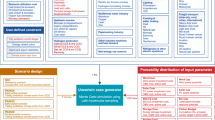Abstract
In this article, the ratio of central station electricity to final energy is used as a measure of electrification. It is well known that this ratio tends to increase with gross domestic product. We show that not only is electrification a characteristic of a reference case with economic growth, but that it is significantly accelerated by a general limitation on carbon emissions. That is, limits on CO2 concentrations, implemented efficiently across the whole economy, result in a higher ratio of electricity to total final energy use. This result reflects the relatively greater suite of options available in reducing CO2 emissions in power generation than in other important components of the economy. Furthermore, electrification is stronger, the more stringent the constraint on CO2 emissions, although the absolute production of electricity may be either greater or smaller in the presence of a CO2 constraint, depending on the technologies available to the sector and to end-use sectors. The base technology scenario we examined was purposefully pessimistic about the evolution of central station and distributed electric technologies, lessening the degree of electrification. The better the performance of the set of options for emissions mitigation in power generation, the greater the acceleration of electrification.
Similar content being viewed by others
References
Alcamo J, Leemans R, Kreileman GJJ (1998) Global change scenarios of the 21st century, results from the IMAGE 2.1 model. Pergamon, London
Edmonds J, Reilly J (1985) Global energy: assessing the future. Oxford University Press, Oxford
Edmonds J, Clarke K, Dooley J, Kim SH, Smith SJ (2004) Stabilization of CO2 in a B2 world: insights on the roles of carbon capture and storage, hydrogen, and transportation technologies. Energy Economics 26:517–537
Energy Information Administration (2003) US Department of Energy, Annual Energy Review 2004, http://www.eia.doe.gov/aer/txt/ptbll01.html, and International Energy Annual (IEA), http://www.eia.doe.gov/emeu/international/electric.html#ConsumptionTotal. Cited Washington D.C., US, September
Fujii Y, Yamaji K (1998) Assessment of technological options in the global energy system for limiting the atmospheric CO2 concentration. Environmental Economics and Policy Studies 1:113–139
Hulme M, Raper SCB, Wigley TML (1995) An integrated framework to address climate change (ESCAPE) and further developments of the global and regional climate modules (MAGICC). Energy Policy 23:347–355
Intergovernmental Panel on Climate Change (IPCC) (1995) Climate change 1994: radiative forcing of climate change and an evaluation of the IPCC IS92 emissions scenarios. Houghton JT, Filho LGM, Bruce J, Lee H, Callander BA, Haites, Harris EN, Maskell K (eds) Cambridge University Press, Cambridge
Kainuma M, Matsuoka Y, Morita T (1999) Analysis of post-Kyoto scenarios: AIM model. Energy Journal Special Issue:207-220
Kurosawa A, Yagita H, Weisheng Z, Tokimatsu K, Yanagisawa Y (1999) Analysis of carbon emissions stabilization targets and adaptation by integrated assessment model. Energy Journal, Special Issue:157-175
Manne AS, Richels RG (1992) Buying greenhouse insurance: the economic costs of CO2 emissions limits. MIT Press, Cambridge, MA, USA
Manne AS, Mendelsohn R, Richels R (1995) MERGE—a model for evaluating regional and global effects of GHG reduction policies. Energy Policy 23:17–34
Messner S, Schrattenholzer L (2000) MESSAGE-MACRO: linking an energy supply model with a macroeconomic module and solving it iteratively. Energy 25:267–282
Messner S, Strubegger M (1995) User’s guide for MESSAGE III, WP-95-69. International Institute for Applied Systems Analysis, Laxenburg, Austria
Mori S (2000) The development of greenhouse gas emissions scenarios using an extension of the MARIA model for the assessment of resource and energy technologies. Technological Forecasting and Social Change 63:289–311
Mori S, Takahashi M (1999) An integrated assessment model for the evaluation of new energy technologies and food productivity. International Journal of Global Energy Issues 11:1–18
Riahi K, Roehrl RA (2000) Greenhouse gas emissions in a dynamics-as-usual scenario of economic and energy development. Technological Forecasting and Social Change 63:175–205
Richels R, Edmonds J, Gruenspecht H, Wigley T (1996) The Berlin mandate: the design of cost-effective mitigation strategies. In: Nakicenovic N, Nordhaus WD, Richels R, Toth FL (eds) Climate change: integrating science, economics and policy. International Institute for Applied Systems Analysis, Laxenburg, Austria, pp 229–248
United Nations (1992) Framework convention on climate change. United Nations, New York
Wigley TML, Richels R, Edmonds JA (1996) Economic and environmental choices in the stabilization of atmospheric CO2 concentrations. Nature 379:240–243
Author information
Authors and Affiliations
Additional information
This article is dedicated to the memory of Tsuneyuki Morita, a pioneer in the field of integrated assessment, a leader in energy-economy and environment research, and a friend.
About this article
Cite this article
Edmonds, J., Wilson, T., Wise, M. et al. Electrification of the economy and CO2 emissions mitigation. Environ Econ Policy Stud 7, 175–203 (2006). https://doi.org/10.1007/BF03353999
Received:
Accepted:
Published:
Issue Date:
DOI: https://doi.org/10.1007/BF03353999




